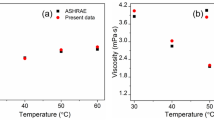Abstract
Although the thermal conductivities and viscosities of nanofluids have been widely measured, relatively few studies concerning their electrical conductivity have been reported. Stable nanofluids consisting of palladium nanoparticles, with a mean particle size of 5.63 nm, were dispersed in distilled water with volume fractions between 0.00 and 1.00 vol%. The palladium nanoparticles were prepared using a reduction method in the presence of ultrasound waves and characterized using X-ray powder diffraction, transmission electron microscopy, and UV–Visible spectroscopy. The electrical conductivity of the nanofluids of palladium nanoparticles in distilled water was measured both as a function of palladium loading and temperature and was found to increase with increasing NP volume fraction and temperature. A 75.67 % increase in the electrical conductivity of distilled water was achieved by NP loading of 1 vol% at 25 °C. It was observed that increasing temperature has a much greater effect on electrical conductivity enhancement than increasing palladium loading.




Similar content being viewed by others
References
Ahmadzadeh H, Prescott M, Muster N, Stoyanov A (2007) Revisiting electroosmotic flow: an important parameter affecting separation in capillary and microchip electrophoresis. Chem Eng Commun 195:129–146
Azizi-Toupkanloo H, Goharshadi EK, Nancarrow P (2014) Structural, electrical, and rheological properties of palladium/silver bimetallic nanoparticles prepared by conventional and ultrasonic-assisted reduction methods. Adv Powder Technol 25:801–810
Bankar A, Joshi B, Kumar AR, Zinjarde S (2010) Banana peel extract mediated novel route for the synthesis of palladium nanoparticles. Mater Lett 64:1951–1953
Chen H, Wei G, Ispas A, Hickey SG, Eychmüller A (2010) Synthesis of palladium nanoparticles and their applications for surface-enhanced Raman scattering and electrocatalysis. J Phys Chem C 114:21976–21981
Felba J (2002) Nanomaterials and technology for conductive microstructures, in: nanotechnology, nanomaterials and nanoelectronics. IEEE 23:205–221
Goharshadi EK, Azizi-Toupkanloo H (2013) Silver colloid nanoparticles: ultrasound-assisted synthesis, electrical and rheological properties. Powder Technol 237:97–101
Goharshadi EK, Ding Y, Jorabchi MN, Nancarrow P (2009) Ultrasound-assisted green synthesis of nanocrystalline ZnO in the ionic liquid [hmim][NTf2]. Ultrason Sonochem 6:120–123
Goharshadi EK, Sajjadi SH, Mehrkhah R, Nancarrow P (2012) Sonochemical synthesis and measurement of optical properties of zinc sulfide quantum dots. Chem Eng J 209:113–117
Goharshadi EK, Ahmadzadeh H, Samiee S, Hadadian M (2013) Nanofluids for heat transfer enhancement—a review. Phys Chem Res 1:1–33
Grace AN, Pandian K (2007) One pot synthesis of polymer protected Pt, Pd, Ag and Ru nanoparticles and nanoprisms under reflux and microwave mode of heating in glycerol—a comparative study. Mater Chem Phys 104:191–198
Hunter RJ (1981) Zeta potential in colloid science, principles and applications. Academic Press, London
Kanchana A, Devarajan S, Ayyappan SR (2010) Green synthesis and characterization of palladium nanoparticles and its conjugates from solanum trilobatum leaf extract. Nano-Micro Lett 2:169–176
Kim SW, Kim M, Lee WY, Hyeon T (2002) Fabrication of hollow palladium spheres and their successful application to the recyclable heterogeneous catalyst for Suzuki coupling reactions. J Am Chem Soc 124:7642–7643
Kole M, Dey TK (2013) Investigation of thermal conductivity, viscosity, and electrical conductivity of graphene based nanofluids. J Appl Phys 113:084307
Liu Y, Hu J, Kong Q, Feng X (2010) Shape-controlled synthesis and application in surface-enhanced Raman scattering of novel palladium nanoparticles. Mater Lett 64:422–424
Lynch WA, Sondergaard NA (2009) Liquid additives to improve conductivity in electric contacts. In: 2009 Proceedings 55th IEEE Holm conference on electrical contacts, pp 78–86
McNamara WB, Didenko YT, Suslick KS (1999) Sonoluminescence temperatures during multi-bubble cavitation. Nature 401:772–775
Minea AA, Luciu RS (2012) Investigations on electrical conductivity of stabilized water based Al2O3 nanofluids. Microfluid Nanofluid 13:977–985
Mubeen S, Zhang T, Yoo B, Deshusses MA, Myung NV (2007) Palladium nanoparticles decorated single-walled carbon nanotube hydrogen sensor. J Phys Chem C 111:6321–6327
Nemamcha A, Rehspringer JL, Khatmi D (2006) Synthesis of palladium nanoparticles by sonochemical reduction of palladium(II) nitrate in aqueous solution. J Phys Chem B 110:383–387
Redon R, Rendon-Lara SK, Fernandez-Osorio AL, Ugalde-Saldivar VM (2011) Aerobic synthesis of palladium nanoparticles. Rev Adv Mater Sci 27:31–42
Sarojini KGK, Manoj SV, Singh PK, Pradeep T, Das SK (2013) Electrical conductivity of ceramic and metallic nanofluids. Colloids Surf A Physicochem Eng Asp 417:39–46
Singh P, Kumar P, Kumari K, Sharma P, Mozumdar S, Chandra R (2011)A rapid and simple route for the synthesis of lead and palladium nanoparticles in tetrazolium based ionic liquid. Spectrochim Acta Part A: Molec Biomol Spectros 78: 909-912
Teranishi T, Miyake M (1998) Size control of palladium nanoparticles and their crystal structures. Chem Mater 10:594–600
Wiley B, Xia Y (2009) Chemical synthesis of novel plasmonic nanoparticles. Annu Rev Phys Chem 60:167–192
Yang X, Li Q, Wang H, Huang J, Lin L, Wang W, Sun D, Su Y, Opiyo JB, Hong L (2010) Green synthesis of palladium nanoparticles using broth of Cinnamomum camphora leaf. J Nanoparticle Res 12:1589–1598
Yu J, Liu RYF, Poon B, Nazarenko KT, Vargo T, Hiltner A, Baer E (2004) Polymers with palladium nanoparticles as active membrane materials. J Appl Polymer Sci 92:749–756
Yu Y, Zhao Y, Huang T, Liu H (2010) Microwave-assisted synthesis of palladium nanocubes and nanobars. Mater Res Bull 45:159–164
Zhu YP, Wang XK, Guo WL, Wang JG, Wang C (2010) Sonochemical synthesis of silver nanorods by reduction of sliver nitrate in aqueous solution. Ultrason Sonochem 17:675–679
Acknowledgments
The authors also express their gratitude to Ferdowsi University of Mashhad for support to this project (17395/1).
Author information
Authors and Affiliations
Corresponding author
Rights and permissions
About this article
Cite this article
Goharshadi, E.K., Azizi-Toupkanloo, H. & Karimi, M. Electrical conductivity of water-based palladium nanofluids. Microfluid Nanofluid 18, 667–672 (2015). https://doi.org/10.1007/s10404-014-1465-0
Received:
Accepted:
Published:
Issue Date:
DOI: https://doi.org/10.1007/s10404-014-1465-0




